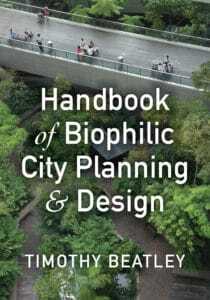Handbook of Biophilic City Planning and Design
Timothy Beatley
Island Press
2000 M Street, NW, Suite 650,
Washington, DC 20036;
www.islandpress.org
January 2017. 312 pages. Hardcover, $80; paperback, $40.00; e-book $39.99.
The term biophilia was coined by psychiatrist Eric Fromm during the 1960s and later championed by esteemed biologist E.O. Wilson (1984) in his evocative book by the same name. The latter envisioned biophilia as “the innately emotional affiliation of human beings to other living organisms.” Although this spiritual and emotional connection to the bounty of the natural world is intrinsic to indigenous tribal cultures, its recognition as an imperative in today’s digital cities has been generally disregarded.
Author Tim Beatley is a relatively recent convert to the biophilia hypothesis, having previously garnered well-deserved repute for promoting the cause of sustainable cities as an antidote to the specter of climate change. The seminal Green Urbanism (published in 1990) was the first in a series of books illuminating the best of European models—places like Malmo, Sweden, and Freiburg, Germany, where a civic culture of admirable urban design, multimodal transportation, and compact development puts most U.S. cities to shame.
This is actually Beatley’s second book on biophilia, and follows on the heels of the Biophilic Cities Project and Biophilic Cities Network launched in 2013 at the University of Virginia, where Beatley is a chaired professor. The jury is still out on whether such initiatives hint that his scholarship is shifting decisively away from the built environment, but a careful reading reveals that his real intent is to demonstrate just how extensive and interdependent the urban and natural realms really are.
One might think that the larger or denser the city, the greater its disconnects with nature. But that is not inevitable. Oslo, Norway, with a population of 570,000, thrives in a context where an astonishing two-thirds of the land area is set aside as protected forest or lake reserves. This vast repository of plant and animal life is easily accessible; from the center of the city by metro rail takes 15 minutes while whisking through neighborhoods where 85 percent of the children get to school by walking, bicycling, or transit.
The “wildness” ethic of Oslo is but one of numerous ways that people can rekindle their contact with nature on a habitual basis, rather than as an occasional escape from the digitally dominated workplace. And if one looks closely enough, nature is abundant even in the most mundane environments. The micro-scale of lichen, ants, bats, bees, and pachysandra all play a vital role in the “naturely city,” argues Beatley.
Other case studies borrowed from the Biophilic Cities Network include the following: Singapore; Wellington, New Zealand; Birmingham, United Kingdom; Vitoria-Gastiez, Spain; and Portland, San Francisco, and Milwaukee in the United States. These locales are where committed leadership is making substantial gains large and small from a biophilic perspective, even though they might not call it that.
Numerous vignettes of biophilic architecture and urban design run the gamut from rooftop greenhouses mounted on a motorcycle parts factory in Neemrana, India, to the tallest green facade in the world at 500 feet (150 m) in Sydney. Other discussions highlight the restoration of polluted rivers, reimagining cities of the future, and current concerns arising when high-profile projects cause dispiriting neighborhood gentrification (the High-Line effect).
This book’s real-life examples made all the more relevant because the author has actually toured and interviewed key actors in so many of the sites he writes about. But its utility as a handbook is questionable if one defines a handbook in the conventional sense as a readily accessible set of rules or guides. Coding especially, too often the Achilles’ heel of the planning and design process, is given short shrift. A robust chapter rather than a few pages here and there would probably have sufficed to bridge this gap (although this topic is soon to be added to the Biophilic Cities Project’s website). And all too often, the reader must work backwards from the index in order to find similar topics of relevance.
Martin Zimmerman writes frequently for Urban Land and directs the Green Mobility Planning Studio USA in Charlotte, North Carolina, a firm with expertise in smart growth, urban place making, and multimodal transportation.





